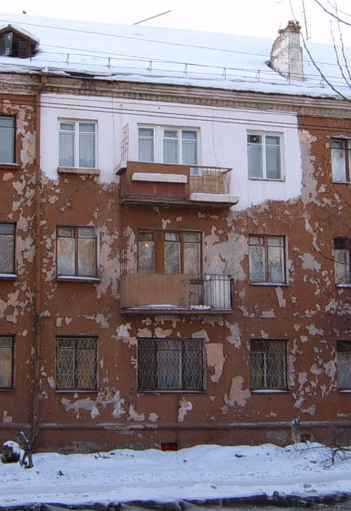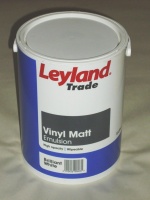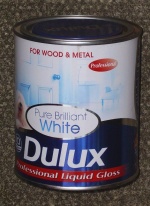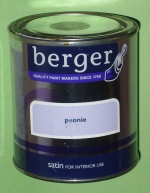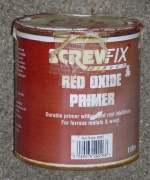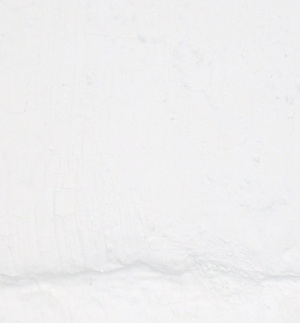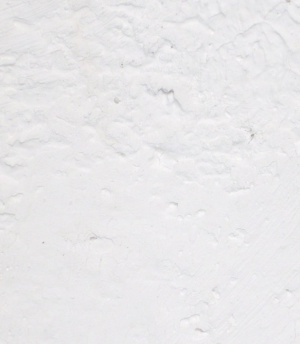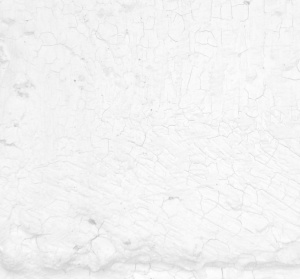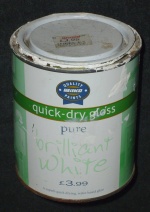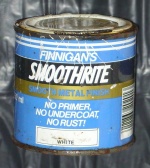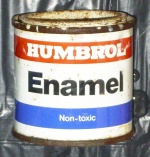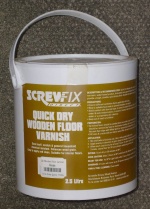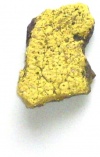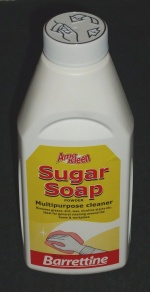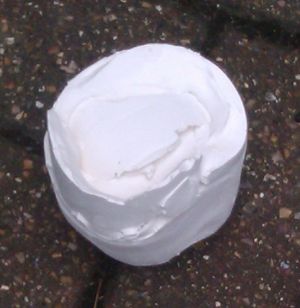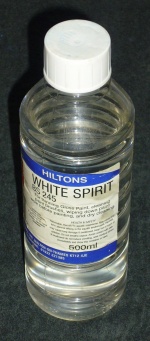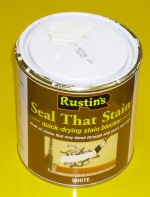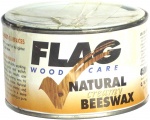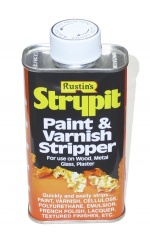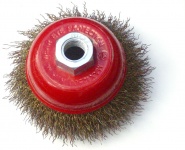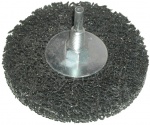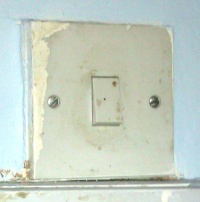Difference between revisions of "Paint"
(→Hammerite & Smoothrite: rewrite) |
(fix messed attempt to revert. should be as it was now!) |
||
| (19 intermediate revisions by the same user not shown) | |||
| Line 9: | Line 9: | ||
[[image:Leyland emulsion 588-3.jpg|right|150px]] | [[image:Leyland emulsion 588-3.jpg|right|150px]] | ||
| − | Emulsion paints are water-soluble until dried, and are the usual choice for covering | + | Emulsion paints are [[water]]-soluble until dried, and are the usual choice for covering [[wall]]s and ceilings. They are available in matt and semi-matt (often known as 'silk') finishes. |
| − | They're prone to [[Mould Basics|mould]] if used in [[:Category:Damp|damp]] environments. Kitchen and bathroom formulations (and others) are available, or a [[Mould Resistant Paint|mouldproofer]] can be added. | + | They're prone to [[Mould Basics|mould]] if used in [[:Category:Damp|damp]] environments. [[Kitchen]] and [[bathroom]] formulations (and others) are available, or a [[Mould Resistant Paint|mouldproofer]] can be added to the paint, or applied separately. |
Prone to mild discolouring if used on radiators. | Prone to mild discolouring if used on radiators. | ||
| Line 20: | Line 20: | ||
Dulux paints at [[Suppliers|DIY sheds]] and Dulux centres aren't the same. Quality and price are higher at the Dulux shops. | Dulux paints at [[Suppliers|DIY sheds]] and Dulux centres aren't the same. Quality and price are higher at the Dulux shops. | ||
| − | |||
| Line 26: | Line 25: | ||
[[image:Gloss dulux 2532-2.jpg|right|150px]] | [[image:Gloss dulux 2532-2.jpg|right|150px]] | ||
| − | * [[Oil]] based | + | * Gloss for [[wood]]work |
| − | * Produces fumes during application and for a few days afterwards | + | * [[Oil]] based alkyd chemistry |
| − | * Use over | + | * Produces fumes during application and for a few days afterwards |
| − | * Water based undercoats or primers can reduce paint life | + | * Use over alkyd undercoat ideally |
| − | * May also be used for | + | * [[Water]] based undercoats or primers can reduce paint life |
| − | * Curing takes longer than drying, so either avoid pressing painted surfaces together as soon as dry (eg door frames), or coat them with a lubricant to avoid sticking, eg [[Detergent|washing up liquid]], binbags or [[Oil|baby oil]] | + | * May also be used for [[wall]]s & ceilings where easy [[cleaning]] and hard wearing are required, but ventilation during and after application is needed |
| − | + | * Curing takes longer than drying, so either avoid pressing painted surfaces together as soon as dry (eg door frames), or coat them with a lubricant to avoid sticking, eg [[Detergent|washing up liquid]], binbags or [[Oil|baby oil]] | |
| Line 38: | Line 37: | ||
[[image:Undercoat 2533-2.jpg|right|150px]] | [[image:Undercoat 2533-2.jpg|right|150px]] | ||
| − | * Oil based undercoats | + | * Oil based alkyd undercoats mainly for use with household gloss. |
* They can also be used as a stain blocking layer under emulsion, but are slow drying for this. | * They can also be used as a stain blocking layer under emulsion, but are slow drying for this. | ||
* Acrylic undercoat can be used as a cheaper but less durable substitute | * Acrylic undercoat can be used as a cheaper but less durable substitute | ||
| − | |||
| Line 51: | Line 49: | ||
* harder wearing than emulsion | * harder wearing than emulsion | ||
* ventilate the area after application | * ventilate the area after application | ||
| − | + | * alkyd chemistry | |
| Line 61: | Line 59: | ||
* Several primer formulae exist | * Several primer formulae exist | ||
| + | |||
| + | ==Acrylic== | ||
| + | * Like emulsion but tougher. | ||
| + | * Sometimes used as an undercoat for alkyd gloss paints | ||
| Line 66: | Line 68: | ||
* For exterior use only | * For exterior use only | ||
* The term covers more than one formulation of paint | * The term covers more than one formulation of paint | ||
| − | * | + | * impermeable exterior paints occasionally causes [[damp]] issues on old non-cavity non-DPC [[wall]]s |
| − | |||
| Line 76: | Line 77: | ||
* The term is also sometimes used to describe distemper or milk paints. | * The term is also sometimes used to describe distemper or milk paints. | ||
* Lasts well outdoors | * Lasts well outdoors | ||
| + | * Finish not as fine as commercial paints, not an issue on exterior surfaces | ||
| + | * Painting technique differs a bit from commercial paints | ||
| + | * Eye protection necessary, lime does grim things to eyes | ||
* Exceptionally cheap at under £7 per 100kg | * Exceptionally cheap at under £7 per 100kg | ||
| + | * See [[Limewash]] | ||
===Preparation=== | ===Preparation=== | ||
| − | # Buy or prepare lime putty. Its prepared by adding [[water]] to builder's lime to make a putty consistency. | + | # Buy or prepare lime putty. Its prepared by adding [[water]] to builder's lime to make a [[putty]] consistency. |
# Dilute the putty 50/50 with water, and you have paint. | # Dilute the putty 50/50 with water, and you have paint. | ||
| Line 89: | Line 94: | ||
===Use=== | ===Use=== | ||
| − | For exterior masonry, just paint it on. Add a second coat the next day, immediate overpainting just takes the first coat off. It looks excessively thin at first, but don't worry, it bodies up on drying, and bodies up again on curing, which takes a couple of days. | + | For exterior [[masonry]], just paint it on. Add a second coat the next day, immediate overpainting just takes the first coat off. It looks excessively thin at first, but don't worry, it bodies up on drying, and bodies up again on curing, which takes a couple of days. Don't put a thicker coat on to try to compensate for its initial thinness, it cracks up on drying if you do. |
Lime paint isn't normally thickened, so it drips quickly from the brush. To minimise drips and maximise work rate, rotate the paint brush while you carry it from can to wall. | Lime paint isn't normally thickened, so it drips quickly from the brush. To minimise drips and maximise work rate, rotate the paint brush while you carry it from can to wall. | ||
| − | Cleanup is especially easy with lime paint, as even after drying it redissolves immediately in [[water]]. Outdoor work can typically be done with no covering of | + | Cleanup is especially easy with lime paint, as even after drying it redissolves immediately in [[water]]. Outdoor work can typically be done with no covering of [[path]]s etc, and the path just rinsed off at the end of the day. If cured, the paint is readily removed with [[acid]]. |
| − | Lime is probably the quickest paint to use, as for most outdoor work there's no need to mask or cover anything, drops don't matter, and cleanup takes seconds with a hose. And single coat work is | + | Lime is probably the quickest paint to use, as for most outdoor work there's no need to mask or cover anything, drops don't matter, and cleanup takes seconds with a hose. And single coat work is sometimes practical. |
Check its not about to rain when painting, it can wash off. Once cured, lime paint is completely rainproof. Dry lime paint is also easily brushed off until it cures. This isn't particularly a problem in practice, as its trivially easy to patch it if ever needed. | Check its not about to rain when painting, it can wash off. Once cured, lime paint is completely rainproof. Dry lime paint is also easily brushed off until it cures. This isn't particularly a problem in practice, as its trivially easy to patch it if ever needed. | ||
| − | Surfaces should be sound before painting, but on occasion the work | + | Surfaces should be sound before painting, but on occasion the extra work isn't justified. In such situations lime paint soaks in and provides a degree of bonding to a loose or powdery substrate. This works fairly well with crumbly old lime [[plaster]], which coats of diluted lime paint can bond back together. [[PVA]] is faster though. |
Lime paint isn't for kids, it can do serious damage to eyes. | Lime paint isn't for kids, it can do serious damage to eyes. | ||
===Colours=== | ===Colours=== | ||
| − | Lime is normally white. | + | Lime is normally white, though off white lime is also available. |
| − | * For a broken white colour, a very small amount of seived subsoil can be mixed in | + | * For a broken white colour, a very small amount of seived subsoil can be mixed in (not topsoil) |
* For pink, add iron oxide, sold as red cement pigment. | * For pink, add iron oxide, sold as red cement pigment. | ||
* For sky blue add laundry blue and use the paint immediately, else it bleaches in a few hours. | * For sky blue add laundry blue and use the paint immediately, else it bleaches in a few hours. | ||
| Line 112: | Line 117: | ||
* Adding kids waterpaints is yet to be tried. It probably would work fine with some colours, but not all. | * Adding kids waterpaints is yet to be tried. It probably would work fine with some colours, but not all. | ||
* Lime is alkaline, and not all pigments are alkali stable. | * Lime is alkaline, and not all pigments are alkali stable. | ||
| − | * | + | * Red, yellow, green, blue and black can be obtained using sheep raddle powder from a farmer's co-op or agrimerchant. |
===Thickness, coats and issues=== | ===Thickness, coats and issues=== | ||
| − | Outdoor work is easily done with 2 coats, but its also possible to use 1 | + | Outdoor work is easily done with 2 coats, but its also possible to use 1 sometimes. Some people prefer 3 thinner coats. |
| − | Its possible to use a single thickish coat of slightly thicker mix for outdoor masonry where a fine finish isn't wanted. Wait until you're familiar with the paint's handling before doing this, as if the mix is too thick the paint | + | Its possible to use a single thickish coat of slightly thicker mix for outdoor masonry where a fine finish isn't wanted. Wait until you're familiar with the paint's handling before doing this, as if the mix is too thick the paint cracks and crazes. If that should happen, just put another coat on top, it fills the cracks and bonds properly. |
| − | + | For a finer finish for indoor work, dilute the paint further and use several thinly applied coats. Use matured putty rather than builder's lime for the smoothest result. | |
| − | + | There's plenty of misinformation about regarding surface compatibility with limewash and distempers, including from sources that should know better. | |
| − | + | ===Paint & fill in one=== | |
| + | An unusual way to apply lime is to use putty without diluting, wiping it on with a rubber grout spreader or similar. This fills the uneven [[masonry]] surface to a fair extent, producing a smoother finish. Its not as smooth as rendering as the lime shrinks, but it does improve the surface, and later repainting makes it smoother again. It acts as [[filler]] and paint in one. A steel trowel is no good for this. | ||
===Piccies=== | ===Piccies=== | ||
| Line 132: | Line 138: | ||
[[image:Lime paint was trowelled 4431-3.jpg|300px]] | [[image:Lime paint was trowelled 4431-3.jpg|300px]] | ||
| − | Picture 2: Top half shows lime painted on, bottom half shows lime putty | + | Picture 2: Top half shows lime painted on, bottom half shows lime putty applied with a rubber edge. |
[[image:Lime paint crazed 4432-3.jpg|300px]] | [[image:Lime paint crazed 4432-3.jpg|300px]] | ||
| − | Picture 3: | + | Picture 3: Here the paint crazed from being put on too thickly. |
| − | Note | + | Note the lightness and colour balance of these doesn't match real life very well. In real life the roughness of the wall makes the features & defects shown barely noticeable. |
==Distemper== | ==Distemper== | ||
| Line 145: | Line 151: | ||
* very matt finish | * very matt finish | ||
* Distemper can be washed off with [[Domestic Hot Water|hot water]] and [[detergent]] | * Distemper can be washed off with [[Domestic Hot Water|hot water]] and [[detergent]] | ||
| − | * Can be cleaned with cold water, but is not as robust as emulsion and will come off with repeated cleaning. | + | * Can be cleaned with cold [[water]], but is not as robust as emulsion and will come off with repeated [[cleaning]]. |
* Well suited to intricate [[Timber basics|mouldings]], as its easy removal avoids paint build up over time obscuring detail. | * Well suited to intricate [[Timber basics|mouldings]], as its easy removal avoids paint build up over time obscuring detail. | ||
| − | * Mostly available in mid and light colours due to chalk content, but | + | * Mostly available in mid and light colours due to chalk content, but darkish colours are possible. |
* Sometimes chosen for its appearance, which is slightly different to emulsion | * Sometimes chosen for its appearance, which is slightly different to emulsion | ||
* Covers hairline cracks, unlike emulsion. | * Covers hairline cracks, unlike emulsion. | ||
| − | * Distemper can be made at home, but so few people do it that its hard to know which recipes produce a cleanable paint. The basic formula is lime, fat, [[Colour | + | * Distemper can be made at home, but so few people do it that its hard to know which recipes produce a cleanable paint. The basic formula is lime, fat, [[Colour scheme|pigment]], [[water]] and [[Heating Articles|heat]]. |
===Potential Confusion=== | ===Potential Confusion=== | ||
| − | There are 2 different types of paint called distemper. There is soft distemper, which is discussed below inder the heading /Whitewash/ and oil bound distemper, discussed here, which is the more versatile paint. Oil bound distemper is a mainly water based paint. | + | There are 2 different types of paint called distemper. There is soft distemper, which is discussed below inder the heading /Whitewash/ and [[oil]] bound distemper, discussed here, which is the more versatile paint. Oil bound distemper is a mainly [[water]] based paint. |
Note that of oil bound distempers there is a fair variety of recipes, and not all perform identically. For example some less successful recipes wash off with detergent in cold [[water]]. This probably accounts for the considerable amount of confused, conflicting and incorrect advice concerning distemper on the net. | Note that of oil bound distempers there is a fair variety of recipes, and not all perform identically. For example some less successful recipes wash off with detergent in cold [[water]]. This probably accounts for the considerable amount of confused, conflicting and incorrect advice concerning distemper on the net. | ||
| − | |||
| − | |||
==Stove enamel== | ==Stove enamel== | ||
| Line 165: | Line 169: | ||
* Relatively expensive | * Relatively expensive | ||
* Not possible to paint such a finish on, the coated item is kilned after application | * Not possible to paint such a finish on, the coated item is kilned after application | ||
| − | + | * Any repair to damaged stove enamel is inevitably of much inferior durability | |
==Powder coat== | ==Powder coat== | ||
* Tough finish for metal goods | * Tough finish for metal goods | ||
| − | * Heated after application. | + | * Dry powder is sprayed onto the item |
| + | * Heated after application to fuse and bond. | ||
* [[Adhesive|Resin]] based | * [[Adhesive|Resin]] based | ||
| − | + | * Widely used on metal [[appliances]] | |
| Line 179: | Line 184: | ||
* Very cheap | * Very cheap | ||
* Short lived | * Short lived | ||
| − | * Useful for temporary applications, such as greenhouse shading, where it gradually washes off in winter | + | * Useful for temporary applications, such as greenhouse summer shading, where it gradually washes off, giving little shade in winter |
| − | |||
| − | |||
| − | It | + | Also known as soft distemper, it was widely used on ceilings until about 50 years ago. It is a matt paint. The natural colour of a greyish shade of white was normally used but occasionally it was tinted. |
| + | It can be (and should be) washed off before another coat is put on. During WW2 it was used on [[wall]]s because it was the only paint readily available, but this gave it a bad name because it easily brushes off onto clothes. If you find an old painted wall that drops chalk when brushed or wiped, its probably this stuff, and probably dates back to at least the 1940s. | ||
| Line 193: | Line 197: | ||
* Durability not comparable to oil based gloss paint | * Durability not comparable to oil based gloss paint | ||
* Not very robust | * Not very robust | ||
| − | |||
| Line 200: | Line 203: | ||
* Synthetic resin | * Synthetic resin | ||
* Pinholes heavily | * Pinholes heavily | ||
| − | * Longer lived than budget masonry paints | + | * Longer lived than budget [[masonry]] paints |
* Contains naphtha | * Contains naphtha | ||
| − | |||
==Linseed oil paint== | ==Linseed oil paint== | ||
* Takes days to dry | * Takes days to dry | ||
| − | * Nice strong smell while drying | + | * Nice but strong smell while drying |
* Non-toxic | * Non-toxic | ||
* Soaks into woodwork | * Soaks into woodwork | ||
* [[Oil|Boiled linseed oil]] is used to ensure drying | * [[Oil|Boiled linseed oil]] is used to ensure drying | ||
* Made with & without added driers (chemicals). Driers speed up drying time but shorten paint life. | * Made with & without added driers (chemicals). Driers speed up drying time but shorten paint life. | ||
| − | |||
| Line 218: | Line 219: | ||
[[image:Smoothrite 3511-4.jpg|150px|right]] | [[image:Smoothrite 3511-4.jpg|150px|right]] | ||
| − | * For metal | + | * For [[metal]] |
* Can be painted directly onto rust | * Can be painted directly onto rust | ||
* No primer or undercoat required | * No primer or undercoat required | ||
| − | * Pinholes badly | + | * Pinholes badly, resulting in rust spots reappearing later |
'Hammerite' paints were originally distinguished by (and named after) their orange peel texture. | 'Hammerite' paints were originally distinguished by (and named after) their orange peel texture. | ||
| Line 235: | Line 236: | ||
* Note the pre-1989 formulation requires a different thinner, [http://groups.google.com/group/uk.d-i-y/browse_frm/thread/0f00c0145a8c794c?hl=en+f3eea16dfb82940# details] | * Note the pre-1989 formulation requires a different thinner, [http://groups.google.com/group/uk.d-i-y/browse_frm/thread/0f00c0145a8c794c?hl=en+f3eea16dfb82940# details] | ||
| − | The current ICI version of Hammerite is an alkyd paint. Cheaper brands of alkyd are available (see household gloss section). | + | The current ICI version of Hammerite is an alkyd paint, and [https://groups.google.com/group/uk.d-i-y/browse_frm/thread/5e5fb475d082b85c?hl=en# not popular] on uk.d-i-y. Cheaper brands of alkyd are available (see household gloss section). |
Some varieties can be applied by sponge roller, which can give a consistent finish free of brush-strokes. | Some varieties can be applied by sponge roller, which can give a consistent finish free of brush-strokes. | ||
| + | |||
==Enamel== | ==Enamel== | ||
| Line 244: | Line 246: | ||
Enamel is not one specific type of paint. It simply means a paint with a hard finish. | Enamel is not one specific type of paint. It simply means a paint with a hard finish. | ||
* The term enamel means the paint imitates stove enamel, which is an optimistic description for any paint | * The term enamel means the paint imitates stove enamel, which is an optimistic description for any paint | ||
| − | * Suited to rigid | + | * Suited to rigid [[metal]]work. |
| − | * Not suitable for wood | + | * Not suitable for [[wood]] |
| − | * | + | * Often a solvent based paint of some sort |
| + | |||
==Car paints== | ==Car paints== | ||
| − | + | * much tougher than a lot of household paints | |
| + | * more expensive | ||
| + | * not flexible enough for use on [[wood]] | ||
| + | * Good for small items that will see a lot of use, eg painted handles. | ||
===Cellulose=== | ===Cellulose=== | ||
| Line 255: | Line 261: | ||
===Acrylic=== | ===Acrylic=== | ||
A less expensive type of car paint used for respray work, still tough but more prone to fade. | A less expensive type of car paint used for respray work, still tough but more prone to fade. | ||
| − | |||
| Line 263: | Line 268: | ||
* [http://en.wikipedia.org/wiki/Japan_Black More info] | * [http://en.wikipedia.org/wiki/Japan_Black More info] | ||
| + | |||
| + | ==Zinc paint== | ||
| + | * Often called cold galvanising paint | ||
| + | * a good option for iron & steel | ||
| + | * Offers some of the benefit of galvanisation: | ||
| + | ** the zinc corrodes in preference to the steel | ||
| + | ** but the paint to substrate bond is much weaker than real galvanisation | ||
| + | ** and only some of the zinc in the paint film is [[water]] accessible | ||
| Line 268: | Line 281: | ||
* Limited range of dull earthy colours possible | * Limited range of dull earthy colours possible | ||
* Minimal cost | * Minimal cost | ||
| − | * Easily made | + | * Easily made, just sieved clay subsoil plus a binder (eg lime, milk, glue etc) |
| − | * May be mixed with lime | + | * May be mixed with lime, red iron oxide and soot to give a limited range of colours. |
| − | + | * Widely used in the 3rd world | |
==Silicate paints== | ==Silicate paints== | ||
| − | + | A type of masonry paint | |
==Vinyl Dye== | ==Vinyl Dye== | ||
* For painting [[:Category:Plastics|plastics]] | * For painting [[:Category:Plastics|plastics]] | ||
| − | * Penetrates the surface of the plastic for a more durable finish | + | * Penetrates the surface of the [[plastic]] for a more durable finish |
* Solvent based | * Solvent based | ||
* Stinks | * Stinks | ||
| − | |||
==2 part polyurethane gloss== | ==2 part polyurethane gloss== | ||
* Marine grade paint | * Marine grade paint | ||
| − | * | + | * Very tough |
* Currently around £40 per litre | * Currently around £40 per litre | ||
| − | * For | + | * For GRP, steel and light alloy |
* Correct primer also required | * Correct primer also required | ||
* Complete stripping normally required before application | * Complete stripping normally required before application | ||
| + | |||
| + | ==2 part epoxy paint== | ||
| + | * Very tough | ||
| + | * Epoxy plus a coloured filler | ||
| + | * Not [[cheap]] | ||
| + | * Small quantities are easily made at home using a cartridge of epoxy, or tiny amounts from retail packs | ||
| Line 299: | Line 317: | ||
Anti-climb should only be used out of reach of people on the ground, and a warning sign should be fitted. | Anti-climb should only be used out of reach of people on the ground, and a warning sign should be fitted. | ||
| − | |||
| Line 307: | Line 324: | ||
Varnishes can be regarded as clear paints. Several formulations exist with their own varying characteristics. Fancy [[Creating and Editing Articles|writing an article]] on them? | Varnishes can be regarded as clear paints. Several formulations exist with their own varying characteristics. Fancy [[Creating and Editing Articles|writing an article]] on them? | ||
| + | |||
| + | ==Road paint== | ||
| + | [[image:Yellow road paint 5168-3.jpg|right|100px]] | ||
| + | |||
| + | The paint used on roads is an approved thermoplastic paint with reflective glass beads. Wearing of the paint surface exposes fresh reflective glass beads. It comes in 25kg bags, and needs a boiler with a mixing paddle to melt. Its not cheap. | ||
| + | |||
| + | Spray cans of road paint don't last well by comparison. | ||
==Coal refurbishment paint== | ==Coal refurbishment paint== | ||
| − | Paint for refurbishing coal? Almost - its for painting artifical coals used in gas & electric fires. | + | Paint for refurbishing coal? Almost - its for painting artifical coals used in gas & [[Electric heating|electric fires]]. |
| − | |||
=Finishes= | =Finishes= | ||
* Gloss - shiny | * Gloss - shiny | ||
| − | * Silk -partial surface shine | + | * Silk & eggshell -partial surface shine |
* Matt - no surface shine, or almost none | * Matt - no surface shine, or almost none | ||
| − | + | * Distemper & limewash are matter than matt emulsion. | |
| − | + | * Car spray paints give more gloss than household gloss. | |
| − | + | * Where the smoothest shiniest finish is wanted, spray the paint. | |
| Line 331: | Line 354: | ||
Sugar soap is the detergent of choice for paintwork. (see [http://groups.google.com/group/uk.d-i-y/browse_frm/thread/341dd56c9217184f?hl=en# Discussion] ) | Sugar soap is the detergent of choice for paintwork. (see [http://groups.google.com/group/uk.d-i-y/browse_frm/thread/341dd56c9217184f?hl=en# Discussion] ) | ||
* Remove any [[Scraper|flaking]] or bubbling paint | * Remove any [[Scraper|flaking]] or bubbling paint | ||
| + | * Remove any unsound surface, or in the case of masonry [[glue]] it together with [[PVA]] | ||
==New plaster== | ==New plaster== | ||
New [[Plastering Beginner's Guide|plaster]] is very absorbent, and needs extra [[water]] for the first coat of paint. There are 2 ways to do this. | New [[Plastering Beginner's Guide|plaster]] is very absorbent, and needs extra [[water]] for the first coat of paint. There are 2 ways to do this. | ||
| + | |||
===Piss coat=== | ===Piss coat=== | ||
| − | * Paint with a 50/50 mix of emulsion and water. | + | * Paint with a 50/50 mix of emulsion and [[water]]. |
| + | |||
===Water coat=== | ===Water coat=== | ||
| − | # Paint the wall with a coat of water. There's no need for any particular care with this, so it can be done very fast. | + | # Paint the wall with a coat of [[water]]. There's no need for any particular care with this, so it can be done very fast. |
# Wait 5 minutes | # Wait 5 minutes | ||
# Paint with normal strength emulsion. | # Paint with normal strength emulsion. | ||
| Line 347: | Line 373: | ||
==Solvent weld plastic== | ==Solvent weld plastic== | ||
| − | Paint adhesion to solvent weldable plastic can be improved by wiping the plastic with solvent before painting. This has an etch like effect on the surface. | + | Paint adhesion to solvent weldable [[plastic]] can be improved by wiping the plastic with solvent before painting. This has an etch like effect on the surface. |
==Unsound Surfaces== | ==Unsound Surfaces== | ||
| − | Surfaces not in good condition should be repaired before painting, but the demands of time and budget sometimes mean that crumbling [[Plastering Beginner's Guide|plaster]] needs to be painted. The simplest approach is to brush off any loose material using a household | + | Surfaces not in good condition should be repaired before painting, but the demands of time and budget sometimes mean that crumbling [[Plastering Beginner's Guide|plaster]] needs to be painted. The simplest approach is to brush off any loose material using a household [[cleaning]] brush, then coat the surface with [[Adhesive|PVA]] diluted 1:4. Once dried this will normally give a surface that will last years if not poked about. |
Don't overdo the PVA. If a slick surface of PVA forms, paint doesn't stick to it, and painting be problematic. | Don't overdo the PVA. If a slick surface of PVA forms, paint doesn't stick to it, and painting be problematic. | ||
| − | If the existing surface is chalky, due to it being deteriorating lime paint or lime plaster, well diluted lime putty is a traditional alternative to PVA. This soaks in and rebonds the materials together, without the downsides of PVA, but | + | If the existing surface is chalky, due to it being deteriorating lime paint or lime plaster, well diluted lime putty is a traditional alternative to PVA. This soaks in and rebonds the materials together, without the downsides of PVA, but several coats are needed. |
==Tobacco staining== | ==Tobacco staining== | ||
| − | Sugar soap is particularly effective at tackling tobacco staining. With staining not too heavy, a few hours of persistence removed more or less all trace of tobacco discolouration. | + | [[Detergent|Sugar soap]] is particularly effective at tackling tobacco staining. With staining not too heavy, a few hours of persistence removed more or less all trace of tobacco discolouration in an average room. |
| Line 368: | Line 394: | ||
* Limewash | * Limewash | ||
* Gloss if a shiny easy clean finish is desired | * Gloss if a shiny easy clean finish is desired | ||
| + | |||
==Walls== | ==Walls== | ||
* Emulsion usually | * Emulsion usually | ||
| + | * Eggshell is a matt alkyd paint, tougher than emulsion | ||
| + | * Household gloss (alkyd) for a tough easy clean finish. Not as good looking as matt paints. | ||
* Distemper | * Distemper | ||
* Limewash for walls subject to light wear | * Limewash for walls subject to light wear | ||
| − | + | ||
==Woodwork== | ==Woodwork== | ||
| − | * | + | * Alkyd gloss usually |
* Waterbased gloss | * Waterbased gloss | ||
* Emulsion can be used but tends to not wear well | * Emulsion can be used but tends to not wear well | ||
* Distemper to preserve fine detail where the woodwork is not subject to heavy wear | * Distemper to preserve fine detail where the woodwork is not subject to heavy wear | ||
* Linseed oil paint | * Linseed oil paint | ||
| − | * Water based | + | * Water based paint (usually emulsion) then varnish |
| + | |||
==Asbestos== | ==Asbestos== | ||
* Emulsion | * Emulsion | ||
* Household gloss | * Household gloss | ||
| + | |||
==Wood floors== | ==Wood floors== | ||
* Paint not recommended, normal wear makes it look very bad in time. | * Paint not recommended, normal wear makes it look very bad in time. | ||
| + | |||
==Concrete floors== | ==Concrete floors== | ||
* Concrete floor paints | * Concrete floor paints | ||
| − | * [[Adhesive|Epoxy]] paints | + | * [[Adhesive|Epoxy]] paints last longer but cost a fair bit more |
| + | |||
==Exterior Masonry== | ==Exterior Masonry== | ||
| − | * | + | * Commercial masonry paints for cavity walls |
| − | * Limewash, especially for old non-cavity walls | + | * Limewash, especially for old non-cavity no DPC walls |
* Pliolite | * Pliolite | ||
| + | |||
==Iron & steel== | ==Iron & steel== | ||
* Car paints | * Car paints | ||
| − | * | + | * Zinc bearing paints |
| + | * Solvent based metal paints | ||
* Enamels | * Enamels | ||
| + | * Hammerite, smoothrite & similar [https://groups.google.com/group/uk.d-i-y/browse_frm/thread/5e5fb475d082b85c?hl=en# aren't much liked] on uk.d-i-y | ||
* Household gloss can be used, but is prone to fade and isn't as tough | * Household gloss can be used, but is prone to fade and isn't as tough | ||
| + | |||
==Fireplaces== | ==Fireplaces== | ||
| + | |||
==Plastics== | ==Plastics== | ||
| Line 413: | Line 451: | ||
** This chemically bonds to the pvc, giving much longer paint life than on wood. | ** This chemically bonds to the pvc, giving much longer paint life than on wood. | ||
* Vinyl dye | * Vinyl dye | ||
| + | |||
=Solvents= | =Solvents= | ||
==Water== | ==Water== | ||
| − | + | [[image:IMAG0025-2 Paint dried lump.jpg|thumb|Needs water]] | |
| + | * for all water based paints, such as emulsion, distemper, lime paints etc. | ||
==Turps substitute== | ==Turps substitute== | ||
| − | * Thins oil | + | * Thins oil & alkyd paints |
* Will also thin linseed paint, but not the best choice for this | * Will also thin linseed paint, but not the best choice for this | ||
| + | * Real turpentine is too expensive for housepainting | ||
| Line 428: | Line 469: | ||
* Very similar to [[Oil|turps substitute]], but affects the paint handling characteristics. Turps substitute is the better choice. | * Very similar to [[Oil|turps substitute]], but affects the paint handling characteristics. Turps substitute is the better choice. | ||
| − | * | + | * Can also thin linseed paint, but not the best choice for this |
* Good choice for brush cleaning with oil based paints | * Good choice for brush cleaning with oil based paints | ||
| − | ** | + | ** Dirty [[Oil|white spirit]] can be left to settle and decanted for re-use |
==Linseed oil== | ==Linseed oil== | ||
| − | * | + | * 2 types of linseed oil exist, raw and boiled. Boiled has added chemical dryers. |
| − | + | * [[Oil|Boiled linseed]] sets in days, raw takes very much longer and is not recommended for paint uses. | |
| − | * [[Oil|Boiled linseed]] sets in days, raw takes very much longer and is not recommended for | + | * Extra chemical dryers can be added to boiled linseed to make it set faster, but the resulting paint is then a bit less durable |
| − | * sometimes used to make lime paint stick to a wider range of surfaces | + | |
| + | * Linseed thins linseed based paints. | ||
| + | * Can also thin other oil based paints, but heavily extends their drying times. | ||
| + | * sometimes used to make lime paint stick to a wider range of surfaces. In the region of 0.5-1.5% is added | ||
==Cellulose thinners== | ==Cellulose thinners== | ||
| − | * for volatile solvent based paints: cellulose, hammerite, | + | * for volatile solvent based paints: cellulose, old xylene based hammerite & smoothrite, etc |
| Line 447: | Line 491: | ||
Mixing paints of the same type is straightforward. It works, and what you see is what you get. | Mixing paints of the same type is straightforward. It works, and what you see is what you get. | ||
* Be sure that every drop of the mix is well mixed | * Be sure that every drop of the mix is well mixed | ||
| − | * Be sure you've mixed enough to do the whole job, trying to match it later | + | * Be sure you've mixed enough to do the whole job, trying to match it later is often unsuccessful |
* Keep some spare mix for maintenance | * Keep some spare mix for maintenance | ||
* Store your spare mix properly so it'll be usable | * Store your spare mix properly so it'll be usable | ||
| Line 458: | Line 502: | ||
Paint mixing can also be used to create special effects if you're willing to experiment. I once mixed 2 types of car paint in blue & green for use on some metal. It took persistence to mix it, but the 2 paints separated during drying, giving a fine hexagonal lattice of one colour filled in with dots of the other. The result was pretty and robust. | Paint mixing can also be used to create special effects if you're willing to experiment. I once mixed 2 types of car paint in blue & green for use on some metal. It took persistence to mix it, but the 2 paints separated during drying, giving a fine hexagonal lattice of one colour filled in with dots of the other. The result was pretty and robust. | ||
| − | |||
=Paint Effects= | =Paint Effects= | ||
| − | + | Paint Effects can liven up an otherwise featureless wall. Effects include: | |
* woodgraining | * woodgraining | ||
* ragrolling | * ragrolling | ||
| Line 471: | Line 514: | ||
* fibres | * fibres | ||
* camouflage | * camouflage | ||
| − | |||
=Paint Styles= | =Paint Styles= | ||
| − | + | A wide range of colour schemes & styles are readily found on search engines. | |
| Line 483: | Line 525: | ||
=Troubleshooting= | =Troubleshooting= | ||
| − | + | ;Cracked paint finish | |
| − | + | : generally due to use of a paint coat that was too thick. | |
| − | + | ;Failure to adhere | |
| − | + | : usually due to surface contamination, eg with [[oil]], grease or excess dust | |
| − | + | ;Shrunken paint patches | |
| − | + | : when putting water based paints over gloss, the old paint should be matted to enable new paint to stick. Otherwise the paint shrinks into little islands while wet (called "cissing"), and it takes several coats to get full coverage. A few options: | |
** paint the gloss with a coat of matt oil paint. | ** paint the gloss with a coat of matt oil paint. | ||
** lightly sand the old gloss first | ** lightly sand the old gloss first | ||
** rub in whiting with a damp cloth. | ** rub in whiting with a damp cloth. | ||
| + | ** Or just persist with painting, after a few coats its all good | ||
| + | |||
* For problems with masking tape see [[Tapes]] | * For problems with masking tape see [[Tapes]] | ||
| − | * Lime paint behaves a bit differenly to other types, see [[Paint#Limewash]] for troubleshooting | + | |
| + | |||
| + | ==Lime== | ||
| + | * Lime rendered exterior walls should be painted with porous paints, if paint is wanted. | ||
| + | * SPAB recommends using porous paints such as lime on the infill of exposed timber frame buildings. Use of impermeable paints traps water, sometimes causing rot | ||
| + | * Brickwork on old houses with no wall cavity should be painted with porous paints such as lime. Such [[wall]]s evaporate [[damp]] from the exterior surface to keep them sufficiently dry, and use of impermeable paints increases water content in the wall. Water both enters into and evaporates from a wall via permeable paint, but evaporation normally exceeds ingress. | ||
| + | * Lime paint behaves a bit differenly to other types, see [[Paint#Limewash]] for troubleshooting | ||
| Line 499: | Line 549: | ||
[[image:Stain block 387-3.jpg|right|150px]] | [[image:Stain block 387-3.jpg|right|150px]] | ||
Stain appearance is due to an underlying stain that is (fully or partly) soluble in the paint being used. 2 options: | Stain appearance is due to an underlying stain that is (fully or partly) soluble in the paint being used. 2 options: | ||
| − | # Use a layer of paint based on a different solvent to block the stain. This normally means using an oil based undercoat on water based paints. | + | # Use a layer of paint based on a different solvent to block the stain. This normally means using an oil based alkyd undercoat on [[water]] based paints. |
# If this doesn't work try a stain block paint, which are sometimes more effective | # If this doesn't work try a stain block paint, which are sometimes more effective | ||
| + | # Water based acrylic can also be used as a stainblock layer | ||
For severe or very stubborn staining, use alternating coats of any 2 of emulsion, oil based matt paint and stain block. Sometimes several coats are needed. | For severe or very stubborn staining, use alternating coats of any 2 of emulsion, oil based matt paint and stain block. Sometimes several coats are needed. | ||
| + | ==Yellowing== | ||
| + | Some paints yellow a bit as they age, such as alkyd gloss. Its limited what can be done about it, but sometimes the following prove useful. | ||
| + | |||
| + | After the fact: | ||
| + | * clean it | ||
| + | * rub with cutting/polishing compound | ||
| + | * rub with a cloth on a buffer machine and diesel (non-metallic non-clearcoated car paints) | ||
| + | |||
| + | Prevention: | ||
| + | * pick a non yellowing paint where practical | ||
| + | * overcoat the paint with a clear non-yellowing finish | ||
| + | * pick a colour that won't show slight yellowing | ||
| + | * add a drop of blue to white paint to disguise slight yellowness | ||
| + | * one uk.d-i-yer uses pale greay instead of white to avoid yellowing being noticeable | ||
=Alternatives to paint= | =Alternatives to paint= | ||
| Line 513: | Line 578: | ||
* Stain | * Stain | ||
* Liming | * Liming | ||
| − | * | + | * [[Oil]]ing |
* No coating | * No coating | ||
| Line 537: | Line 602: | ||
* Cladding | * Cladding | ||
* Bare brick/stone/wood etc | * Bare brick/stone/wood etc | ||
| + | |||
=Paint retouching= | =Paint retouching= | ||
| − | Paint retouching may be used between | + | Paint retouching may be used between repaints to extend the life of existing paint finishes. It can also be used when there is not enough time to repaint. |
Paint retouching is a fast minimal cost way to make a house look in much better decorative order. The ok can be made to look good, and even the tatty can be made to look ok. | Paint retouching is a fast minimal cost way to make a house look in much better decorative order. The ok can be made to look good, and even the tatty can be made to look ok. | ||
| Line 546: | Line 612: | ||
| − | ==Oil paint== | + | ==Alkyd/Oil paint== |
| − | # Clean the existing paintwork. This | + | # [[Clean]] the existing paintwork. This brightens it up as well as cleans it. |
# Obtain a teaspoonful or a miniature pot of matching paint. If you don't already have the paint you need, match to a cleaned fragment of paint, otherwise you won't get quite the right colour. | # Obtain a teaspoonful or a miniature pot of matching paint. If you don't already have the paint you need, match to a cleaned fragment of paint, otherwise you won't get quite the right colour. | ||
# Colour matching is critical. | # Colour matching is critical. | ||
| Line 556: | Line 622: | ||
# Never allow any paint whatever to overlap the edges of the chip hollows. Absolutely none. Its not necessary to fill the hollows fully, but any overlap at all ruins the effect. | # Never allow any paint whatever to overlap the edges of the chip hollows. Absolutely none. Its not necessary to fill the hollows fully, but any overlap at all ruins the effect. | ||
| − | This method works very well if the 2 golden rules are followed, but looks like a poor bodge if they're not. | + | This method works very well if the 2 golden rules are followed, but it looks like a poor bodge if they're not. |
==Emulsion== | ==Emulsion== | ||
| − | Simply paint over any marks on the wall. Use the minimum amount of paint possible, aim for a layer that covers imperfectly. The trick is to avoid patches that look new, so don't put too much on | + | Simply paint over any marks on the [[wall]]. Use the minimum amount of paint possible, aim for a layer that covers imperfectly. The trick is to avoid patches that look new, so don't put too much on. |
| − | |||
| − | |||
| + | The result isn't as good as touched up gloss paint, the patches are visible, but as long as only a thin paint layer is added they don't stand out, and they do make a [[wall]] look a lot better than unpatched, enabling it to go longer before repainting. | ||
=Removal of Paint= | =Removal of Paint= | ||
| − | Several removal methods are unsafe to use with historic paintwork. See [[#Toxic Paints]] section. | + | Several removal methods are unsafe to use with [[History|historic]] paintwork. See [[#Toxic Paints]] section. |
==Blowlamp== | ==Blowlamp== | ||
| − | * A cause of house | + | * A cause of house [[fire]]s and damage to [[wood]]work |
* Not advised with lead paints | * Not advised with lead paints | ||
| Line 581: | Line 646: | ||
==IR Heatgun== | ==IR Heatgun== | ||
* Used around windows this avoids the risk of [[Heating|heat]] cracking the glass. | * Used around windows this avoids the risk of [[Heating|heat]] cracking the glass. | ||
| − | * More energy efficient, as the heat | + | * More energy efficient, as the heat isn't being blown away |
* Heat absorption dependant on paint colour | * Heat absorption dependant on paint colour | ||
| Line 600: | Line 665: | ||
===Caustic soda=== | ===Caustic soda=== | ||
* Strips oil based paints | * Strips oil based paints | ||
| − | * Caustic soda with wallpaper paste added makes a gel which keeps the stripper in contact with the workpiece. | + | * Caustic soda with [[Glue|wallpaper paste]] added makes a gel which keeps the stripper in contact with the workpiece. |
* Caustic destroys wallpaper paste unless its concentration is kept fairly low. | * Caustic destroys wallpaper paste unless its concentration is kept fairly low. | ||
* Caustic & wallpaper paste makes a low cost stripper | * Caustic & wallpaper paste makes a low cost stripper | ||
| Line 606: | Line 671: | ||
* No toxic fumes | * No toxic fumes | ||
* Splashes to the eye can cause major damage over time after the incident, so any such splash must be treated immediately and properly. Seek medical assistance. | * Splashes to the eye can cause major damage over time after the incident, so any such splash must be treated immediately and properly. Seek medical assistance. | ||
| − | * Neutralise caustic residue with a mild acid before repainting, eg citric acid or vinegar. | + | * Neutralise caustic residue with a mild [[acid]] before repainting, eg [[Acid|citric acid]] or [[Acid|vinegar]]. |
| Line 620: | Line 685: | ||
===Ecover washing up liquid=== | ===Ecover washing up liquid=== | ||
| − | + | * Removes emulsion paints. Soak in a dilute solution overnight and the paint just wipes off. Long soaking is often impractical though | |
| − | * Removes emulsion paints. Soak in a dilute solution | ||
| Line 630: | Line 694: | ||
===Acids=== | ===Acids=== | ||
| − | * Remove all lime based paints | + | * Remove all lime based paints on contact |
| + | * See [[acid]] | ||
==Dip stripping== | ==Dip stripping== | ||
| − | Dip stripping baths are routinely run until so weak that long immersion times are needed. Long immersion in caustic attacks the [[Wood glues|glues]] in the workpiece, often resulting in | + | Dip stripping baths are routinely run until so weak that long immersion times are needed. Long immersion in caustic attacks the [[Wood glues|glues]] in the workpiece, often resulting in [[door]]s cracking apart and joints coming loose. The [[wood]] surface is also often left in poor condition after a dip strip. Dip stripping is quicker than hand stripping, but has a habit of producing poor results and damage. Where the woodwork is of value, dip stripping is best avoided. |
| Line 646: | Line 711: | ||
[[image:Wire cup wheel 5451-3.jpg|right|185px]] | [[image:Wire cup wheel 5451-3.jpg|right|185px]] | ||
| − | High speed wire wheels (run on [[Angle Grinder Discs|angle grinders]]) are extremely effective paint removers. They | + | High speed wire wheels (run on [[Angle Grinder Discs|angle grinders]]) are extremely effective paint removers. They also damage [[wood]] surfaces quite a bit unless used lightly, and even then are much too rough for goods with a fine finish. These are a fast way to remove paint from hard surfaces (eg tough concrete) or where surface finish is unimportant. There is no paint tough enough to resist them, but they don't get into depressions in a rough workpiece. |
Low speed wheels (run in a drill) are reasonably effective, but a little force may need applying to get it to do the job, and they won't always remove everything. | Low speed wheels (run in a drill) are reasonably effective, but a little force may need applying to get it to do the job, and they won't always remove everything. | ||
| − | Miniature wire wheels run in a [[ | + | Miniature wire wheels run in a [[die grinder]] are effective for very small areas of detail. |
| + | |||
| + | Since all of these are rotary wheels, none reach into corners properly. | ||
| − | |||
==Paint stripping wheel== | ==Paint stripping wheel== | ||
| − | [[image:Paint remove disc 2600- | + | [[image:Paint remove disc 2600-4.jpg|right|150px]] |
| − | |||
| − | |||
| − | |||
| + | Abrasive impregnated nylon mesh disc, used with drill or [[angle grinder]]. Far less damaging than wire wheel, though not as effective. | ||
=Toxic paints= | =Toxic paints= | ||
| − | White lead, grey lead and red lead are well known. Some lead paints are still in use. Historic arsenic green paints are also found occasionally. | + | White lead, grey lead and red lead are well known. Some lead paints are still in use. Historic arsenic green paints are also found very occasionally. |
The others are unlikely to be encountered in house paints, but are readily found in artist's murals, frescoes etc. | The others are unlikely to be encountered in house paints, but are readily found in artist's murals, frescoes etc. | ||
| Line 671: | Line 735: | ||
; Cremnitz white : lead carbonate | ; Cremnitz white : lead carbonate | ||
; Grey lead : lead monoxide | ; Grey lead : lead monoxide | ||
| − | ; Red lead : | + | ; Red lead : lead |
| − | |||
| − | |||
; chrome yellows : lead chromate | ; chrome yellows : lead chromate | ||
| Line 681: | Line 743: | ||
; Cadmium yellows | ; Cadmium yellows | ||
; Chrome green : lead chromate | ; Chrome green : lead chromate | ||
| − | ; Schweinfurt green : | + | ; [http://en.wikipedia.org/wiki/Paris_Green Paris green], emerald green, Schweinfurt green, (Paul) Veronese green, Emerald green, C.I. Pigment Green 21, Imperial Green, Vienna Green, Mitis Green : seldom contains copper acetoarsenite |
| − | ; | + | ; Scheele's green : seldom contains copper acetoarsenite |
; Cadmium reds | ; Cadmium reds | ||
; Cadmium orange | ; Cadmium orange | ||
| − | ; Viridian : | + | ; Viridian : chromium |
; Chrome oxide | ; Chrome oxide | ||
; Manganese blue | ; Manganese blue | ||
; Manganese violet | ; Manganese violet | ||
| − | ; Cobalt violet : | + | ; [http://www.webexhibits.org/pigments/indiv/history/coviolet.html Cobalt violet] : seldom contains cobalt arsenate |
| − | ; Raw & burnt umber : | + | ; Raw & burnt umber : manganese |
; Vermilion : mercuric sulfide | ; Vermilion : mercuric sulfide | ||
==Removal of toxic paints== | ==Removal of toxic paints== | ||
| − | Lead paints are common, more so on older houses. They are still in use, although much less common than previously, and | + | ===Lead=== |
| + | Lead paints are common, more so on older houses. They are still in use, although much less common than previously, and were widely used on buildings as recent as the 1970s. They can cause serious health problems if handled wrongly. | ||
| − | + | On exterior surfaces its generally safer to leave lead paint in place and overpaint it rather than remove it. This also gives the benefit of greater [[woodworm]] resistance and a more durable base coat. Interior lead is a risk to chewing young children. | |
| − | + | Leaded paints should be removed when necessary in a manner which does not produce dust, and traps any dust that may occur. A gel paint stripper is ideal. Lead paints should not be removed with a blowtorch or hot air gun, or by sanding, which produce dust and disperse it into the air. | |
| − | + | ===Arsenic & others=== | |
| + | Arsenic pigmented paints are rare, being mainly used in the 1700s and 1800s. Removal of those also poses a health risk. In damp locations, a reaction may occur liberating an arsenic gaseous compound (arsine). | ||
| − | Handling of paints containing arsenic and other toxins is beyond the scope of this article | + | Handling of paints containing arsenic and other toxins is beyond the scope of this article. |
| + | ===More info=== | ||
For paint testing services, a good place to look is [[water]] testing companies, who test drinking water for a wide range of contaminants. | For paint testing services, a good place to look is [[water]] testing companies, who test drinking water for a wide range of contaminants. | ||
[http://groups.google.co.uk/group/uk.d-i-y/browse_frm/thread/e90e9830b5080ecb/eadbad7afe47bc71#eadbad7afe47bc71 More information on toxic paints] | [http://groups.google.co.uk/group/uk.d-i-y/browse_frm/thread/e90e9830b5080ecb/eadbad7afe47bc71#eadbad7afe47bc71 More information on toxic paints] | ||
| + | |||
| + | =Don't paint= | ||
| + | [[image:IMAG0245-2 painted electrics.jpg|right|200px]] | ||
| + | |||
| + | That's what it'll look like later. | ||
| Line 726: | Line 796: | ||
[[Category:Safety]] | [[Category:Safety]] | ||
[[Category:Decorating]] | [[Category:Decorating]] | ||
| + | [[Category:History]] | ||
Latest revision as of 02:07, 5 May 2015
Paint can transform appearance, it can make a style, it can emphasise desired features and partially obscure others.
Types of Paint
Emulsion
Emulsion paints are water-soluble until dried, and are the usual choice for covering walls and ceilings. They are available in matt and semi-matt (often known as 'silk') finishes.
They're prone to mould if used in damp environments. Kitchen and bathroom formulations (and others) are available, or a mouldproofer can be added to the paint, or applied separately.
Prone to mild discolouring if used on radiators.
Covering ability varies widely: the best (such as Dulux Trade) have a mayonnaise-like consistency and can cover even dark colours with 2 or 3 coats, normally requiring only one to give a good coverage on light surfaces. By contrast some 'shed' own brands require many coats to cover even light surfaces. The thicker consistency paints are also less prone to splattering when applied with a roller.
A wide range of colours is available off the shelf and major brands offer ranges which can be mixed to almost any required colour.
Dulux paints at DIY sheds and Dulux centres aren't the same. Quality and price are higher at the Dulux shops.
Household gloss
- Gloss for woodwork
- Oil based alkyd chemistry
- Produces fumes during application and for a few days afterwards
- Use over alkyd undercoat ideally
- Water based undercoats or primers can reduce paint life
- May also be used for walls & ceilings where easy cleaning and hard wearing are required, but ventilation during and after application is needed
- Curing takes longer than drying, so either avoid pressing painted surfaces together as soon as dry (eg door frames), or coat them with a lubricant to avoid sticking, eg washing up liquid, binbags or baby oil
Undercoat
- Oil based alkyd undercoats mainly for use with household gloss.
- They can also be used as a stain blocking layer under emulsion, but are slow drying for this.
- Acrylic undercoat can be used as a cheaper but less durable substitute
Eggshell
- Oil based matt paint
- mainly used on walls
- harder wearing than emulsion
- ventilate the area after application
- alkyd chemistry
Primer
- A good quality primer underneath oil based paints makes them last better.
- An inferior primer can cause premature failure
- Several primer formulae exist
Acrylic
- Like emulsion but tougher.
- Sometimes used as an undercoat for alkyd gloss paints
Masonry paint
- For exterior use only
- The term covers more than one formulation of paint
- impermeable exterior paints occasionally causes damp issues on old non-cavity non-DPC walls
Limewash
- Lime putty & water
- Dead matt finish
- Limewash looks very thin on initial application, but bodies up both through drying and through carbonation over several days after application
- The term is also sometimes used to describe distemper or milk paints.
- Lasts well outdoors
- Finish not as fine as commercial paints, not an issue on exterior surfaces
- Painting technique differs a bit from commercial paints
- Eye protection necessary, lime does grim things to eyes
- Exceptionally cheap at under £7 per 100kg
- See Limewash
Preparation
- Buy or prepare lime putty. Its prepared by adding water to builder's lime to make a putty consistency.
- Dilute the putty 50/50 with water, and you have paint.
When extra sticking ability is needed, 1% of boiled linseed oil may be mixed in.
Adding skimmed milk to lime paint is occasionally done to improve toughness, but this is only good for indoor use.
Builder's lime gives a coarser paint than a mature putty. It suits exterior masonry.
Use
For exterior masonry, just paint it on. Add a second coat the next day, immediate overpainting just takes the first coat off. It looks excessively thin at first, but don't worry, it bodies up on drying, and bodies up again on curing, which takes a couple of days. Don't put a thicker coat on to try to compensate for its initial thinness, it cracks up on drying if you do.
Lime paint isn't normally thickened, so it drips quickly from the brush. To minimise drips and maximise work rate, rotate the paint brush while you carry it from can to wall.
Cleanup is especially easy with lime paint, as even after drying it redissolves immediately in water. Outdoor work can typically be done with no covering of paths etc, and the path just rinsed off at the end of the day. If cured, the paint is readily removed with acid.
Lime is probably the quickest paint to use, as for most outdoor work there's no need to mask or cover anything, drops don't matter, and cleanup takes seconds with a hose. And single coat work is sometimes practical.
Check its not about to rain when painting, it can wash off. Once cured, lime paint is completely rainproof. Dry lime paint is also easily brushed off until it cures. This isn't particularly a problem in practice, as its trivially easy to patch it if ever needed.
Surfaces should be sound before painting, but on occasion the extra work isn't justified. In such situations lime paint soaks in and provides a degree of bonding to a loose or powdery substrate. This works fairly well with crumbly old lime plaster, which coats of diluted lime paint can bond back together. PVA is faster though.
Lime paint isn't for kids, it can do serious damage to eyes.
Colours
Lime is normally white, though off white lime is also available.
- For a broken white colour, a very small amount of seived subsoil can be mixed in (not topsoil)
- For pink, add iron oxide, sold as red cement pigment.
- For sky blue add laundry blue and use the paint immediately, else it bleaches in a few hours.
- Where a heavily weathered appearance is wanted quickly, add a little yogurt or rotted horse manure to the mix for quick biofilm formation.
- Coloured emulsion can be added in small amounts
- Adding kids waterpaints is yet to be tried. It probably would work fine with some colours, but not all.
- Lime is alkaline, and not all pigments are alkali stable.
- Red, yellow, green, blue and black can be obtained using sheep raddle powder from a farmer's co-op or agrimerchant.
Thickness, coats and issues
Outdoor work is easily done with 2 coats, but its also possible to use 1 sometimes. Some people prefer 3 thinner coats.
Its possible to use a single thickish coat of slightly thicker mix for outdoor masonry where a fine finish isn't wanted. Wait until you're familiar with the paint's handling before doing this, as if the mix is too thick the paint cracks and crazes. If that should happen, just put another coat on top, it fills the cracks and bonds properly.
For a finer finish for indoor work, dilute the paint further and use several thinly applied coats. Use matured putty rather than builder's lime for the smoothest result.
There's plenty of misinformation about regarding surface compatibility with limewash and distempers, including from sources that should know better.
Paint & fill in one
An unusual way to apply lime is to use putty without diluting, wiping it on with a rubber grout spreader or similar. This fills the uneven masonry surface to a fair extent, producing a smoother finish. Its not as smooth as rendering as the lime shrinks, but it does improve the surface, and later repainting makes it smoother again. It acts as filler and paint in one. A steel trowel is no good for this.
Piccies
Picture 1: Lime paint on semi-rough concrete's still good 7 years on.
Picture 2: Top half shows lime painted on, bottom half shows lime putty applied with a rubber edge.
Picture 3: Here the paint crazed from being put on too thickly.
Note the lightness and colour balance of these doesn't match real life very well. In real life the roughness of the wall makes the features & defects shown barely noticeable.
Distemper
- The forerunner of modern emulsion
- very matt finish
- Distemper can be washed off with hot water and detergent
- Can be cleaned with cold water, but is not as robust as emulsion and will come off with repeated cleaning.
- Well suited to intricate mouldings, as its easy removal avoids paint build up over time obscuring detail.
- Mostly available in mid and light colours due to chalk content, but darkish colours are possible.
- Sometimes chosen for its appearance, which is slightly different to emulsion
- Covers hairline cracks, unlike emulsion.
- Distemper can be made at home, but so few people do it that its hard to know which recipes produce a cleanable paint. The basic formula is lime, fat, pigment, water and heat.
Potential Confusion
There are 2 different types of paint called distemper. There is soft distemper, which is discussed below inder the heading /Whitewash/ and oil bound distemper, discussed here, which is the more versatile paint. Oil bound distemper is a mainly water based paint.
Note that of oil bound distempers there is a fair variety of recipes, and not all perform identically. For example some less successful recipes wash off with detergent in cold water. This probably accounts for the considerable amount of confused, conflicting and incorrect advice concerning distemper on the net.
Stove enamel
- A hard thick coating
- An exceptionally tough thick paint-like finish
- Used on cookers, a minority of high end cookware, and some other goods with long life expectancy
- Relatively expensive
- Not possible to paint such a finish on, the coated item is kilned after application
- Any repair to damaged stove enamel is inevitably of much inferior durability
Powder coat
- Tough finish for metal goods
- Dry powder is sprayed onto the item
- Heated after application to fuse and bond.
- Resin based
- Widely used on metal appliances
Whitewash
- Whiting (chalk powder) and water soluble glue.
- Very cheap
- Short lived
- Useful for temporary applications, such as greenhouse summer shading, where it gradually washes off, giving little shade in winter
Also known as soft distemper, it was widely used on ceilings until about 50 years ago. It is a matt paint. The natural colour of a greyish shade of white was normally used but occasionally it was tinted.
It can be (and should be) washed off before another coat is put on. During WW2 it was used on walls because it was the only paint readily available, but this gave it a bad name because it easily brushes off onto clothes. If you find an old painted wall that drops chalk when brushed or wiped, its probably this stuff, and probably dates back to at least the 1940s.
Water based gloss
- A semi-gloss household paint used for interior woodwork
- Durability not comparable to oil based gloss paint
- Not very robust
Pliolite
- Matt
- Synthetic resin
- Pinholes heavily
- Longer lived than budget masonry paints
- Contains naphtha
Linseed oil paint
- Takes days to dry
- Nice but strong smell while drying
- Non-toxic
- Soaks into woodwork
- Boiled linseed oil is used to ensure drying
- Made with & without added driers (chemicals). Driers speed up drying time but shorten paint life.
Hammerite & Smoothrite
- For metal
- Can be painted directly onto rust
- No primer or undercoat required
- Pinholes badly, resulting in rust spots reappearing later
'Hammerite' paints were originally distinguished by (and named after) their orange peel texture.
There are 3 versions of hammerite:
- Finnegans pre-1989
- Finnegans post 1989
- ICI
Finnegan's hammerite was a xylene based solvent paint. It pinholed a lot, so rust spots soon reappear and spread. Other manufacturers produce solvent based metal paints, including Ronson, Dulux and others.
Xylene (for thinning paint) isn't cheap. Cellulose thinners have been used successfully at a fraction of the cost.
- Note the pre-1989 formulation requires a different thinner, details
The current ICI version of Hammerite is an alkyd paint, and not popular on uk.d-i-y. Cheaper brands of alkyd are available (see household gloss section).
Some varieties can be applied by sponge roller, which can give a consistent finish free of brush-strokes.
Enamel
Enamel is not one specific type of paint. It simply means a paint with a hard finish.
- The term enamel means the paint imitates stove enamel, which is an optimistic description for any paint
- Suited to rigid metalwork.
- Not suitable for wood
- Often a solvent based paint of some sort
Car paints
- much tougher than a lot of household paints
- more expensive
- not flexible enough for use on wood
- Good for small items that will see a lot of use, eg painted handles.
Cellulose
Tough long lasting car paint.
Acrylic
A less expensive type of car paint used for respray work, still tough but more prone to fade.
Japan black
- A high durability low cost black paint.
- Very popular during the early part of the 20th century.
- More info
Zinc paint
- Often called cold galvanising paint
- a good option for iron & steel
- Offers some of the benefit of galvanisation:
- the zinc corrodes in preference to the steel
- but the paint to substrate bond is much weaker than real galvanisation
- and only some of the zinc in the paint film is water accessible
Clay paints
- Limited range of dull earthy colours possible
- Minimal cost
- Easily made, just sieved clay subsoil plus a binder (eg lime, milk, glue etc)
- May be mixed with lime, red iron oxide and soot to give a limited range of colours.
- Widely used in the 3rd world
Silicate paints
A type of masonry paint
Vinyl Dye
- For painting plastics
- Penetrates the surface of the plastic for a more durable finish
- Solvent based
- Stinks
2 part polyurethane gloss
- Marine grade paint
- Very tough
- Currently around £40 per litre
- For GRP, steel and light alloy
- Correct primer also required
- Complete stripping normally required before application
2 part epoxy paint
- Very tough
- Epoxy plus a coloured filler
- Not cheap
- Small quantities are easily made at home using a cartridge of epoxy, or tiny amounts from retail packs
Anti climb paint
This paint never sets, and is used to deter and mark climbing intruders. It can be bought ready made, or (so we're told) made by mixing equal amounts of household gloss and engine oil. Presumably it accumulates bugs over time.
Anti-climb should only be used out of reach of people on the ground, and a warning sign should be fitted.
Varnish
Varnishes can be regarded as clear paints. Several formulations exist with their own varying characteristics. Fancy writing an article on them?
Road paint
The paint used on roads is an approved thermoplastic paint with reflective glass beads. Wearing of the paint surface exposes fresh reflective glass beads. It comes in 25kg bags, and needs a boiler with a mixing paddle to melt. Its not cheap.
Spray cans of road paint don't last well by comparison.
Coal refurbishment paint
Paint for refurbishing coal? Almost - its for painting artifical coals used in gas & electric fires.
Finishes
- Gloss - shiny
- Silk & eggshell -partial surface shine
- Matt - no surface shine, or almost none
- Distemper & limewash are matter than matt emulsion.
- Car spray paints give more gloss than household gloss.
- Where the smoothest shiniest finish is wanted, spray the paint.
Preparation
General
Its possible to paint directly onto almost any household surface, but a little preparation helps ensure good results.
- Clean the surface.
Sugar soap is the detergent of choice for paintwork. (see Discussion )
- Remove any flaking or bubbling paint
- Remove any unsound surface, or in the case of masonry glue it together with PVA
New plaster
New plaster is very absorbent, and needs extra water for the first coat of paint. There are 2 ways to do this.
Piss coat
- Paint with a 50/50 mix of emulsion and water.
Water coat
- Paint the wall with a coat of water. There's no need for any particular care with this, so it can be done very fast.
- Wait 5 minutes
- Paint with normal strength emulsion.
- This method is quicker and no paint mixing is involved.
- Gives a full strength coat rather than a thin coat.
- If you paint before the water has soaked in the paint doesn't stick to the wall, if you make this mistake just give it a few more minutes.
Solvent weld plastic
Paint adhesion to solvent weldable plastic can be improved by wiping the plastic with solvent before painting. This has an etch like effect on the surface.
Unsound Surfaces
Surfaces not in good condition should be repaired before painting, but the demands of time and budget sometimes mean that crumbling plaster needs to be painted. The simplest approach is to brush off any loose material using a household cleaning brush, then coat the surface with PVA diluted 1:4. Once dried this will normally give a surface that will last years if not poked about.
Don't overdo the PVA. If a slick surface of PVA forms, paint doesn't stick to it, and painting be problematic.
If the existing surface is chalky, due to it being deteriorating lime paint or lime plaster, well diluted lime putty is a traditional alternative to PVA. This soaks in and rebonds the materials together, without the downsides of PVA, but several coats are needed.
Tobacco staining
Sugar soap is particularly effective at tackling tobacco staining. With staining not too heavy, a few hours of persistence removed more or less all trace of tobacco discolouration in an average room.
Paints by purpose
Ceilings
- Emulsion usually
- Distemper
- Limewash
- Gloss if a shiny easy clean finish is desired
Walls
- Emulsion usually
- Eggshell is a matt alkyd paint, tougher than emulsion
- Household gloss (alkyd) for a tough easy clean finish. Not as good looking as matt paints.
- Distemper
- Limewash for walls subject to light wear
Woodwork
- Alkyd gloss usually
- Waterbased gloss
- Emulsion can be used but tends to not wear well
- Distemper to preserve fine detail where the woodwork is not subject to heavy wear
- Linseed oil paint
- Water based paint (usually emulsion) then varnish
Asbestos
- Emulsion
- Household gloss
Wood floors
- Paint not recommended, normal wear makes it look very bad in time.
Concrete floors
- Concrete floor paints
- Epoxy paints last longer but cost a fair bit more
Exterior Masonry
- Commercial masonry paints for cavity walls
- Limewash, especially for old non-cavity no DPC walls
- Pliolite
Iron & steel
- Car paints
- Zinc bearing paints
- Solvent based metal paints
- Enamels
- Hammerite, smoothrite & similar aren't much liked on uk.d-i-y
- Household gloss can be used, but is prone to fade and isn't as tough
Fireplaces
Plastics
- Vinyl dye
PVC
- Household gloss topcoat, no undercoat or primer
- This chemically bonds to the pvc, giving much longer paint life than on wood.
- Vinyl dye
Solvents
Water
- for all water based paints, such as emulsion, distemper, lime paints etc.
Turps substitute
- Thins oil & alkyd paints
- Will also thin linseed paint, but not the best choice for this
- Real turpentine is too expensive for housepainting
White spirit
- Very similar to turps substitute, but affects the paint handling characteristics. Turps substitute is the better choice.
- Can also thin linseed paint, but not the best choice for this
- Good choice for brush cleaning with oil based paints
- Dirty white spirit can be left to settle and decanted for re-use
Linseed oil
- 2 types of linseed oil exist, raw and boiled. Boiled has added chemical dryers.
- Boiled linseed sets in days, raw takes very much longer and is not recommended for paint uses.
- Extra chemical dryers can be added to boiled linseed to make it set faster, but the resulting paint is then a bit less durable
- Linseed thins linseed based paints.
- Can also thin other oil based paints, but heavily extends their drying times.
- sometimes used to make lime paint stick to a wider range of surfaces. In the region of 0.5-1.5% is added
Cellulose thinners
- for volatile solvent based paints: cellulose, old xylene based hammerite & smoothrite, etc
Mixing
Mixing paints of the same type is straightforward. It works, and what you see is what you get.
- Be sure that every drop of the mix is well mixed
- Be sure you've mixed enough to do the whole job, trying to match it later is often unsuccessful
- Keep some spare mix for maintenance
- Store your spare mix properly so it'll be usable
- Mixing can turn unpleasant colour leftovers plus white into nice pastel paints
Mixing paints with different base formulae isn't recommended, but isn't a no-go either.
- sometimes it works fine
- sometimes it doesn't work, they just won't mix
- sometimes it works but colour issues occur, eg the colour changes noticeably during drying.
Paint mixing can also be used to create special effects if you're willing to experiment. I once mixed 2 types of car paint in blue & green for use on some metal. It took persistence to mix it, but the 2 paints separated during drying, giving a fine hexagonal lattice of one colour filled in with dots of the other. The result was pretty and robust.
Paint Effects
Paint Effects can liven up an otherwise featureless wall. Effects include:
- woodgraining
- ragrolling
- spotting
- marbling
- sprayed fades
- colourwash
- fibres
- camouflage
Paint Styles
A wide range of colour schemes & styles are readily found on search engines.
Online Paint Scheme Tool
Paint schemes can be tried out at Online Paint Scheme Tool though its worth bearing in mind that on-screen colours will not generally be accurate.
Troubleshooting
- Cracked paint finish
- generally due to use of a paint coat that was too thick.
- Failure to adhere
- usually due to surface contamination, eg with oil, grease or excess dust
- Shrunken paint patches
- when putting water based paints over gloss, the old paint should be matted to enable new paint to stick. Otherwise the paint shrinks into little islands while wet (called "cissing"), and it takes several coats to get full coverage. A few options:
- paint the gloss with a coat of matt oil paint.
- lightly sand the old gloss first
- rub in whiting with a damp cloth.
- Or just persist with painting, after a few coats its all good
- For problems with masking tape see Tapes
Lime
- Lime rendered exterior walls should be painted with porous paints, if paint is wanted.
- SPAB recommends using porous paints such as lime on the infill of exposed timber frame buildings. Use of impermeable paints traps water, sometimes causing rot
- Brickwork on old houses with no wall cavity should be painted with porous paints such as lime. Such walls evaporate damp from the exterior surface to keep them sufficiently dry, and use of impermeable paints increases water content in the wall. Water both enters into and evaporates from a wall via permeable paint, but evaporation normally exceeds ingress.
- Lime paint behaves a bit differenly to other types, see Paint#Limewash for troubleshooting
Stains
Stain appearance is due to an underlying stain that is (fully or partly) soluble in the paint being used. 2 options:
- Use a layer of paint based on a different solvent to block the stain. This normally means using an oil based alkyd undercoat on water based paints.
- If this doesn't work try a stain block paint, which are sometimes more effective
- Water based acrylic can also be used as a stainblock layer
For severe or very stubborn staining, use alternating coats of any 2 of emulsion, oil based matt paint and stain block. Sometimes several coats are needed.
Yellowing
Some paints yellow a bit as they age, such as alkyd gloss. Its limited what can be done about it, but sometimes the following prove useful.
After the fact:
- clean it
- rub with cutting/polishing compound
- rub with a cloth on a buffer machine and diesel (non-metallic non-clearcoated car paints)
Prevention:
- pick a non yellowing paint where practical
- overcoat the paint with a clear non-yellowing finish
- pick a colour that won't show slight yellowing
- add a drop of blue to white paint to disguise slight yellowness
- one uk.d-i-yer uses pale greay instead of white to avoid yellowing being noticeable
Alternatives to paint
For Wood
- Varnish
- Wax
- Stain
- Liming
- Oiling
- No coating
For Walls
- Wallpaper
- Fabric drapes
- Panelling
- Wood cladding
- PVC cladding, not highly recommended
For Ceilings
- Wallpaper
- Fabric drapes
For Metal
- Polishing
- Plating
- Varnish/lacquer
For exterior walls
- Removing all paint with a stripper eg caustic
- Pebbledash
- Cladding
- Bare brick/stone/wood etc
Paint retouching
Paint retouching may be used between repaints to extend the life of existing paint finishes. It can also be used when there is not enough time to repaint.
Paint retouching is a fast minimal cost way to make a house look in much better decorative order. The ok can be made to look good, and even the tatty can be made to look ok.
Typically a room can be decorated this way using a teaspoonful of paint or less.
Alkyd/Oil paint
- Clean the existing paintwork. This brightens it up as well as cleans it.
- Obtain a teaspoonful or a miniature pot of matching paint. If you don't already have the paint you need, match to a cleaned fragment of paint, otherwise you won't get quite the right colour.
- Colour matching is critical.
- Use an artists brush with the matching paint to fill in any chips in the paint finish.
The 2 golden rules:
- Paint tint must never be brighter than the existing paintwork, not by the tiniest bit. The match must be either exact or the new paint should be a fraction duller.
- Never allow any paint whatever to overlap the edges of the chip hollows. Absolutely none. Its not necessary to fill the hollows fully, but any overlap at all ruins the effect.
This method works very well if the 2 golden rules are followed, but it looks like a poor bodge if they're not.
Emulsion
Simply paint over any marks on the wall. Use the minimum amount of paint possible, aim for a layer that covers imperfectly. The trick is to avoid patches that look new, so don't put too much on.
The result isn't as good as touched up gloss paint, the patches are visible, but as long as only a thin paint layer is added they don't stand out, and they do make a wall look a lot better than unpatched, enabling it to go longer before repainting.
Removal of Paint
Several removal methods are unsafe to use with historic paintwork. See #Toxic Paints section.
Blowlamp
Heatgun
- Not advised with lead paints
IR Heatgun
- Used around windows this avoids the risk of heat cracking the glass.
- More energy efficient, as the heat isn't being blown away
- Heat absorption dependant on paint colour
Steaming
A steamer which is normally used to strip wallpaper can be very effective in lifting layers of paint and should be safe to use on lead paint
Scraper
A scraper is the most popular method
Sanding
- Not advised with lead paints
Stripping chemicals
Caustic soda
- Strips oil based paints
- Caustic soda with wallpaper paste added makes a gel which keeps the stripper in contact with the workpiece.
- Caustic destroys wallpaper paste unless its concentration is kept fairly low.
- Caustic & wallpaper paste makes a low cost stripper
- Avoid skin contact, caustic burns.
- No toxic fumes
- Splashes to the eye can cause major damage over time after the incident, so any such splash must be treated immediately and properly. Seek medical assistance.
- Neutralise caustic residue with a mild acid before repainting, eg citric acid or vinegar.
Methylene Chloride
Methylene chloride, also known as dichloromethane, will strip nearly any type of paint. It is fast acting and aggressive. It is a solvent with an array of known toxic effects, and good ventilation is important in use. Use it outdoors when possible.
Boiled linseed oil
- Linseed oil softens oil based paints
Ecover washing up liquid
- Removes emulsion paints. Soak in a dilute solution overnight and the paint just wipes off. Long soaking is often impractical though
Alcohol
- Softens emulsion
- Long soak needed
Acids
- Remove all lime based paints on contact
- See acid
Dip stripping
Dip stripping baths are routinely run until so weak that long immersion times are needed. Long immersion in caustic attacks the glues in the workpiece, often resulting in doors cracking apart and joints coming loose. The wood surface is also often left in poor condition after a dip strip. Dip stripping is quicker than hand stripping, but has a habit of producing poor results and damage. Where the woodwork is of value, dip stripping is best avoided.
Electric Scraper
Electric scrapers have a vibrating blade, and are reasonably good at pulling layered paint off.
Wire wheel
High speed wire wheels (run on angle grinders) are extremely effective paint removers. They also damage wood surfaces quite a bit unless used lightly, and even then are much too rough for goods with a fine finish. These are a fast way to remove paint from hard surfaces (eg tough concrete) or where surface finish is unimportant. There is no paint tough enough to resist them, but they don't get into depressions in a rough workpiece.
Low speed wheels (run in a drill) are reasonably effective, but a little force may need applying to get it to do the job, and they won't always remove everything.
Miniature wire wheels run in a die grinder are effective for very small areas of detail.
Since all of these are rotary wheels, none reach into corners properly.
Paint stripping wheel
Abrasive impregnated nylon mesh disc, used with drill or angle grinder. Far less damaging than wire wheel, though not as effective.
Toxic paints
White lead, grey lead and red lead are well known. Some lead paints are still in use. Historic arsenic green paints are also found very occasionally.
The others are unlikely to be encountered in house paints, but are readily found in artist's murals, frescoes etc.
A list of some of the more common toxic paint pigments:
- Flake white
- lead carbonate
- Cremnitz white
- lead carbonate
- Grey lead
- lead monoxide
- Red lead
- lead
- chrome yellows
- lead chromate
Less common:
- Naples yellow
- sometimes includes lead antimoniate
- Cadmium yellows
- Chrome green
- lead chromate
- Paris green, emerald green, Schweinfurt green, (Paul) Veronese green, Emerald green, C.I. Pigment Green 21, Imperial Green, Vienna Green, Mitis Green
- seldom contains copper acetoarsenite
- Scheele's green
- seldom contains copper acetoarsenite
- Cadmium reds
- Cadmium orange
- Viridian
- chromium
- Chrome oxide
- Manganese blue
- Manganese violet
- Cobalt violet
- seldom contains cobalt arsenate
- Raw & burnt umber
- manganese
- Vermilion
- mercuric sulfide
Removal of toxic paints
Lead
Lead paints are common, more so on older houses. They are still in use, although much less common than previously, and were widely used on buildings as recent as the 1970s. They can cause serious health problems if handled wrongly.
On exterior surfaces its generally safer to leave lead paint in place and overpaint it rather than remove it. This also gives the benefit of greater woodworm resistance and a more durable base coat. Interior lead is a risk to chewing young children.
Leaded paints should be removed when necessary in a manner which does not produce dust, and traps any dust that may occur. A gel paint stripper is ideal. Lead paints should not be removed with a blowtorch or hot air gun, or by sanding, which produce dust and disperse it into the air.
Arsenic & others
Arsenic pigmented paints are rare, being mainly used in the 1700s and 1800s. Removal of those also poses a health risk. In damp locations, a reaction may occur liberating an arsenic gaseous compound (arsine).
Handling of paints containing arsenic and other toxins is beyond the scope of this article.
More info
For paint testing services, a good place to look is water testing companies, who test drinking water for a wide range of contaminants.
More information on toxic paints
Don't paint
That's what it'll look like later.
